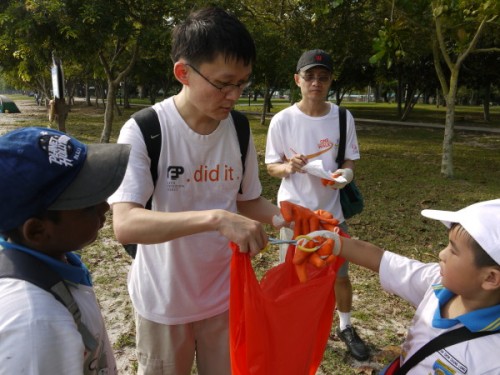“Can you help me print 3 copies of the data card before you come down!” – I hollered over the phone to my primary school friend I had shanghai-ed as an ICCS Site Buddy, Dennis Chew.
Yes, I confess – yours truly, the Changi Zone Captain, had brought the gloves, trash bags, weighing scales and pens for the Independent Volunteers but forgot about the all-important Data Card!
So even as my dear friend Dennis was about to head out to pick me up, I was asking him to return home to print Data Cards!
After a mad rush of 30 minutes, we arrived on time at Changi Carpark 6 to start ICCS. Phew!! We did pay a price – we had to abandon our hot and eagerly anticipated Changi Village breakfast!
Some of the Independents were already waiting for us – a group PSB Academy students from Korea, China and Singapore. Too late to sign up as an independent group, we had invited them to sign up as Independents @ Changi instead.

Hardworking independents
Their site was not an easy one – I had allocated them Changi Site 3 which has a higher trash load than Sites 1 or 2 and is less accessible – the nearest bus stop is a 10-minute walk away. But here they were, bright and chirpy.
I set my trusty site buddy Dennis to work with the Independents and headed out to drop in on various groups.
My first stop was Compassvale Secondary led by Mrs Winnie Lim where I kicked-off their cleanup with a briefing. Some students were bleary-eyed but I piqued their attention by asking “Why are you here to clean the beach? This is a recreational beach cleaned by contract workers who do a much better job on a daily basis!”
Yup, that’s right. At recreational beaches like this one, the main objective of ICCS is the data collection aspect which helps all of us understand the trash profile on the shore. With the objective realised, I felt confident as I left them to the trash and data collection.
After dropping in to meet the hardworking Girl Guides Singapore (South Division c/o Queensway Girl Guides) and Baxter Bioscience, I then called up my chauffeur to drive me to Changi Sites 1 and 2.
That’s right – my chauffeur! Who was none other than my dear site buddy and good friend, Dennis Chew. So for the rest of the morning, he drove me around and accompanied me as if we were on a campaign trail – visiting groups, talking to Organisers and participants and finally collecting their votes.. erm.. I meant consolidated Data Cards.
I did not manage to visit some groups but they were doing great – such as Dow Chemical Pacific (Singapore) Pte Ltd led by Linda Lim. She texted me when she arrived and submitted the data all typed in excel that afternoon; great job!
It was cool to see Black & Veatch (SEA) Pte Ltd led by Chen Feng who were all togged out in an event T-shirt. Catrin Huxtable was leading the Australian International School Singapore, and they were thorough, picking up small lumps of crude oil probably left over from the oil spill last May.
Our final stop on the campaign trail was to debrief one corporate group. With one of their top trash items being plastic containers, I compared the disposable plastic water bottle Organisers had provided to volunteers and the reusable Camelbak water bottle one of the company staff was drinking from.
Yup, it is that simple. With ICCS data pointing to the prevalence of single-use plastics reaching our beaches, we emphasise many ways to combat this – responsible disposal of trash, less use of resources or the use of biodegradeable material. But the most effective method is to avoid the use of plastic disposables in the first place!
Easily available now are reusable water bottles, carrier bags, tupperwares and the like. With reducing disposables being the most effective strategy, it is no wonder that “Reduce” leads the way in the 3Rs.
If you wonder if washing a reusable bottles will use more resources such as water and detergent as compared to disposables, check out this ecological intelligence article by the author of Emotional intelligence, Daniel Goleman in New York Times.
“Reusing” is a concept not only for daily necessities but for friends as well. Hmm, I wonder if I can I use my friend Dennis again at next year’s ICCS!
See you at the beach, everyone!












































![29iccs-Changi-SSC[calebteo].jpg](https://i0.wp.com/farm2.static.flickr.com/1348/1389455565_9cf0ca189a.jpg)
![25iccs-Changi-SSC[calebteo].jpg](https://i0.wp.com/farm2.static.flickr.com/1149/1390345406_63f806b301.jpg)
![31iccs-Changi-SSC[calebteo].jpg](https://i0.wp.com/farm2.static.flickr.com/1234/1390352346_60cc3c6f26.jpg)

